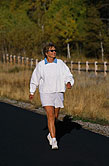 |
 |
 |

Walking Is Good for Blocked Leg Arteries
Study shows value of exercise in treating peripheral arterial disease|
|
HealthDay
Thursday, January 15, 2009
 TUESDAY, Jan. 13 (HealthDay News) -- Anyone looking for proof that a planned program of walking is good for people with the leg blood-vessel blockage called peripheral arterial disease (PAD) should check the results of a new U.S. government-funded study.
TUESDAY, Jan. 13 (HealthDay News) -- Anyone looking for proof that a planned program of walking is good for people with the leg blood-vessel blockage called peripheral arterial disease (PAD) should check the results of a new U.S. government-funded study.
The study of 156 people with PAD -- many of whom didn't have the pain that is the classic symptom of artery blockage -- showed that regular six-minute walks on a treadmill improved their endurance and quality of life.
While walking is a standard recommendation for people with PAD, the study was different in two ways, said study lead author Dr. Mary M. McDermott, a professor of medicine at Northwestern University's Feinberg School of Medicine in Chicago.
"All prior studies have focused on patients with intermittent claudicating -- the symptom of PAD," McDermott said. "Some of the patients in this study were asymptomatic. Also, we included testing of leg strength. This is the largest trial to do so."
The findings were published in the Jan. 14 issue of the Journal of the American Medical Association.
Over the six months of the study, the participants who did their regular six-minute treadmill walks increased their walking distance by about 69 feet, while those who did not walk regularly saw a decrease of 49 feet.
There are several reasons for the increase in performance, said Ronald Terjung, professor of physiology at the University of Missouri, who has done a series of animal studies that looked at the basic science involved with PAD.
"There is the potential for greater oxygen extraction from the blood under maximum exercise conditions," Terjung said. "The muscles can make better use of blood flow and the oxygen release that comes from it."
The animal studies also showed that such exercise leads to improvement in "collateral circulation" -- growth in the number of blood vessels supplying the legs, Terjung said. "There was clearly a dramatic increase in collateral circulation in animal studies," he said.
Improved collateral circulation has not been seen in many human PAD studies of walking, he acknowledged, "but it can be very difficult to measure this kind of blood flow in patients."
Whatever the reason for improvement seen in the new study, McDermott said, "clinicians should urge all PAD patients, whether or not they have symptoms, to engage in a regular, supervised exercise program."
A recommended regimen is a 40-minute walk three times a week for at least six months, McDermott said. The walking can be done on a treadmill or a sidewalk, but it is best done with a trainer standing by, she said.
"You need a trainer, because if you start to get symptoms, you can stop and then start again until you have done the 40 minutes," she said.
Identifying PAD can be difficult for the average person. One recent study found that three-quarters of adult Americans know little or nothing about the condition, which is estimated to affect one of every 16 Americans 40 or older.
Persistent leg pain is an indication that help is needed, McDermott said. In the absence of that symptom, physicians can test for PAD by measuring the difference in blood pressure between an ankle and an arm, she said.
HealthDay
Copyright (c) 2009 ScoutNews, LLC. All rights reserved.
Related News:
More News on this Date
Related MedlinePlus Pages:
| Home | Health Topics | Drugs & Supplements | Encyclopedia | Dictionary | News | Directories | Other Resources | |
| Disclaimers | Copyright | Privacy | Accessibility | Quality Guidelines U.S. National Library of Medicine, 8600 Rockville Pike, Bethesda, MD 20894 National Institutes of Health | Department of Health & Human Services |
Date last updated: 16 January 2009 |




